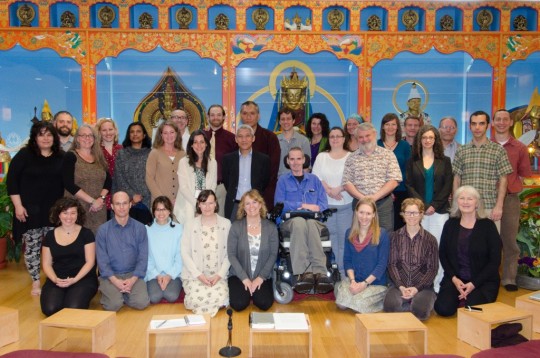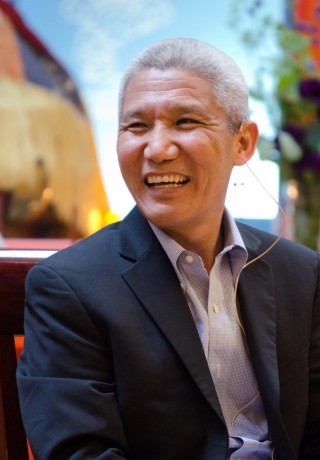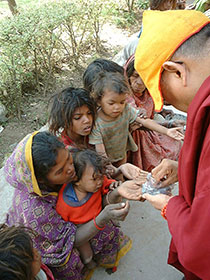- Home
- FPMT Homepage
Foundation for the Preservation of the Mahayana Tradition
The FPMT is an organization devoted to preserving and spreading Mahayana Buddhism worldwide by creating opportunities to listen, reflect, meditate, practice and actualize the unmistaken teachings of the Buddha and based on that experience spreading the Dharma to sentient beings. We provide integrated education through which people’s minds and hearts can be transformed into their highest potential for the benefit of others, inspired by an attitude of universal responsibility and service. We are committed to creating harmonious environments and helping all beings develop their full potential of infinite wisdom and compassion. Our organization is based on the Buddhist tradition of Lama Tsongkhapa of Tibet as taught to us by our founders Lama Thubten Yeshe and Lama Thubten Zopa Rinpoche.
- Willkommen
Die Stiftung zur Erhaltung der Mahayana Tradition (FPMT) ist eine Organisation, die sich weltweit für die Erhaltung und Verbreitung des Mahayana-Buddhismus einsetzt, indem sie Möglichkeiten schafft, den makellosen Lehren des Buddha zuzuhören, über sie zur reflektieren und zu meditieren und auf der Grundlage dieser Erfahrung das Dharma unter den Lebewesen zu verbreiten.
Wir bieten integrierte Schulungswege an, durch denen der Geist und das Herz der Menschen in ihr höchstes Potential verwandelt werden zum Wohl der anderen – inspiriert durch eine Haltung der universellen Verantwortung und dem Wunsch zu dienen. Wir haben uns verpflichtet, harmonische Umgebungen zu schaffen und allen Wesen zu helfen, ihr volles Potenzial unendlicher Weisheit und grenzenlosen Mitgefühls zu verwirklichen.
Unsere Organisation basiert auf der buddhistischen Tradition von Lama Tsongkhapa von Tibet, so wie sie uns von unseren Gründern Lama Thubten Yeshe und Lama Thubten Zopa Rinpoche gelehrt wird.
- Bienvenidos
La Fundación para la preservación de la tradición Mahayana (FPMT) es una organización que se dedica a preservar y difundir el budismo Mahayana en todo el mundo, creando oportunidades para escuchar, reflexionar, meditar, practicar y actualizar las enseñanzas inconfundibles de Buda y en base a esa experiencia difundir el Dharma a los seres.
Proporcionamos una educación integrada a través de la cual las mentes y los corazones de las personas se pueden transformar en su mayor potencial para el beneficio de los demás, inspirados por una actitud de responsabilidad y servicio universales. Estamos comprometidos a crear ambientes armoniosos y ayudar a todos los seres a desarrollar todo su potencial de infinita sabiduría y compasión.
Nuestra organización se basa en la tradición budista de Lama Tsongkhapa del Tíbet como nos lo enseñaron nuestros fundadores Lama Thubten Yeshe y Lama Zopa Rinpoche.
A continuación puede ver una lista de los centros y sus páginas web en su lengua preferida.
- Bienvenue
L’organisation de la FPMT a pour vocation la préservation et la diffusion du bouddhisme du mahayana dans le monde entier. Elle offre l’opportunité d’écouter, de réfléchir, de méditer, de pratiquer et de réaliser les enseignements excellents du Bouddha, pour ensuite transmettre le Dharma à tous les êtres. Nous proposons une formation intégrée grâce à laquelle le cœur et l’esprit de chacun peuvent accomplir leur potentiel le plus élevé pour le bien d’autrui, inspirés par le sens du service et une responsabilité universelle. Nous nous engageons à créer un environnement harmonieux et à aider tous les êtres à épanouir leur potentiel illimité de compassion et de sagesse. Notre organisation s’appuie sur la tradition guéloukpa de Lama Tsongkhapa du Tibet, telle qu’elle a été enseignée par nos fondateurs Lama Thoubtèn Yéshé et Lama Zopa Rinpoché.
Visitez le site de notre Editions Mahayana pour les traductions, conseils et nouvelles du Bureau international en français.
Voici une liste de centres et de leurs sites dans votre langue préférée
- Benvenuto
L’FPMT è un organizzazione il cui scopo è preservare e diffondere il Buddhismo Mahayana nel mondo, creando occasioni di ascolto, riflessione, meditazione e pratica dei perfetti insegnamenti del Buddha, al fine di attualizzare e diffondere il Dharma fra tutti gli esseri senzienti.
Offriamo un’educazione integrata, che può trasformare la mente e i cuori delle persone nel loro massimo potenziale, per il beneficio di tutti gli esseri, ispirati da un’attitudine di responsabilità universale e di servizio.
Il nostro obiettivo è quello di creare contesti armoniosi e aiutare tutti gli esseri a sviluppare in modo completo le proprie potenzialità di infinita saggezza e compassione.
La nostra organizzazione si basa sulla tradizione buddhista di Lama Tsongkhapa del Tibet, così come ci è stata insegnata dai nostri fondatori Lama Thubten Yeshe e Lama Zopa Rinpoche.
Di seguito potete trovare un elenco dei centri e dei loro siti nella lingua da voi prescelta.
- 欢迎 / 歡迎
简体中文
“护持大乘法脉基金会”( 英文简称:FPMT。全名:Foundation for the Preservation of the Mahayana Tradition) 是一个致力于护持和弘扬大乘佛法的国际佛教组织。我们提供听闻,思维,禅修,修行和实证佛陀无误教法的机会,以便让一切众生都能够享受佛法的指引和滋润。
我们全力创造和谐融洽的环境, 为人们提供解行并重的完整佛法教育,以便启发内在的环宇悲心及责任心,并开发内心所蕴藏的巨大潜能 — 无限的智慧与悲心 — 以便利益和服务一切有情。
FPMT的创办人是图腾耶喜喇嘛和喇嘛梭巴仁波切。我们所修习的是由两位上师所教导的,西藏喀巴大师的佛法传承。
繁體中文
護持大乘法脈基金會”( 英文簡稱:FPMT。全名:Found
ation for the Preservation of the Mahayana Tradition ) 是一個致力於護持和弘揚大乘佛法的國際佛教組織。我們提供聽聞, 思維,禪修,修行和實證佛陀無誤教法的機會,以便讓一切眾生都能 夠享受佛法的指引和滋潤。 我們全力創造和諧融洽的環境,
為人們提供解行並重的完整佛法教育,以便啟發內在的環宇悲心及責 任心,並開發內心所蘊藏的巨大潛能 — 無限的智慧與悲心 – – 以便利益和服務一切有情。 FPMT的創辦人是圖騰耶喜喇嘛和喇嘛梭巴仁波切。
我們所修習的是由兩位上師所教導的,西藏喀巴大師的佛法傳承。 察看道场信息:
- FPMT Homepage
- News/Media
-
- Study & Practice
-
-
- About FPMT Education Services
- Latest News
- Programs
- New to Buddhism?
- Buddhist Mind Science: Activating Your Potential
- Heart Advice for Death and Dying
- Discovering Buddhism
- Living in the Path
- Exploring Buddhism
- FPMT Basic Program
- FPMT Masters Program
- FPMT In-Depth Meditation Training
- Maitripa College
- Lotsawa Rinchen Zangpo Translator Program
- Universal Education for Compassion & Wisdom
- Online Learning Center
-
- Prayers & Practice Materials
- Overview of Prayers & Practices
- Full Catalogue of Prayers & Practice Materials
- Explore Popular Topics
- Benefiting Animals
- Chenrezig Resources
- Death & Dying Resources
- Lama Chopa (Guru Puja)
- Lama Zopa Rinpoche: Compendium of Precious Instructions
- Lama Zopa Rinpoche: Life Practice Advice
- Lama Zopa Rinpoche Practice Series
- Lamrim Resources
- Mantras
- Prayer Book Updates
- Purification Practices
- Sutras
- Thought Transformation (Lojong)
- Audio Materials
- Dharma Dates - Tibetan Calendar
- Translation Services
- Publishing Services
- Ways to Offer Support
- Prayers & Practice Materials
-
- Teachings and Advice
- Find Teachings and Advice
- Lama Zopa Rinpoche Advice Page
- Lama Zopa Rinpoche: Compendium of Precious Instructions
- Lama Zopa Rinpoche Video Teachings
- ༧སྐྱབས་རྗེ་བཟོད་པ་རིན་པོ་ཆེ་མཆོག་ནས་སྩལ་བའི་བཀའ་སློབ་བརྙན་འཕྲིན།
- Podcasts
- Lama Yeshe Wisdom Archive
- Buddhism FAQ
- Dharma for Young People
- Resources on Holy Objects
- Teachings and Advice
-
-
*If a menu item has a submenu clicking once will expand the menu clicking twice will open the page.
-
-
- Centers
-
- Teachers
-
- Projects
-
-
-
-
*If a menu item has a submenu clicking once will expand the menu clicking twice will open the page.
-
-
- FPMT
-
- Shop
-
-
-
The Foundation Store is FPMT’s online shop and features a vast selection of Buddhist study and practice materials written or recommended by our lineage gurus. These items include homestudy programs, prayers and practices in PDF or eBook format, materials for children, and other resources to support practitioners.
Items displayed in the shop are made available for Dharma practice and educational purposes, and never for the purpose of profiting from their sale. Please read FPMT Foundation Store Policy Regarding Dharma Items for more information.
-
-
12
Tibetan Translation: Comments from a Master, Geshe Thupten Jinpa
In 2011 FPMT Translation Services organized “Taking Up the Challenge of Translating Buddhism,” a translation and editorial conference that focused on discussing the future of translation within the FPMT. Since this conference, FPMT Translation Services has been working towards creating a coherent Tibetan to English translation policy for the organization in order to address a number of critical issues ranging from terminology and consistency to translation style.

Geshe Thupten Jinpa with Maitripa College students , staff and President Yangsi Rinpoche. May, 2015. Photo by Marc Sakamoto.
Geshe Thupten Jinpa, PhD, principal translator of His Holiness the Dalai Lama since 1985, visited Maitripa College in Portland, Oregon, USA, May 10-12, 2015. While there, he spoke to Maitripa’s translation students about issues in translating Tibetan. His answers to students’ questions, which range in topic from importance of interpretative-communicative translation, the poetry of translation, as well as suggestions for future focus which are not only relevant to this current work, but also to translation in the more distant future, have been transcribed and edited by Maitripa student and Mandala contributor Donna Lynn Brown.
What are the priorities and opportunities right now for translation?
Twenty years ago there were very few translators, but now there are a lot. Are there enough? I don’t think so. There are still a huge number of texts needing to be translated.
I would like to see a lot more instructional materials out there, including, especially, those of Gelug masters. At the moment, there are many Lam Rim texts, but a lot of Gelug practice texts haven’t been translated. Most of the “instructions on the view” (lta khri) genre still needs to be translated. An important one is Maitriyogi’s Instructions of Three Essential Points; instructions from this and associated texts are, at the moment, not in widespread use in Gelug circles. But if you look at the collected works of Gelug masters of the past, almost every major Gelug master wrote a guide on this particular practice. And it’s all instructions based on Avalokiteshvara, highest yoga tantra, as revealed by the mystical experience of Maitriyogi. These are very moving and powerful practices for the three essential times, which are waking life, bardo, and the point of death. Also, most of the Gelug Mahamudra textual tradition is still to be translated. My own translation focus to date has been more on Tibetan traditions as a whole, rather than Gelug works in particular. But there are specific Gelug instructional texts that need to be done. And some of these are very accessible, very inspiring, and one would be immediately able to practice them.

Geshe Thupten Jinpa speaking at Maitripa College, Portland, OR, May 2015. Photo by Marc Sakamoto.
What is necessary to produce a high quality translation?
I actually read the final product aloud, especially if it is a verse text. How does it sound? Because English is a very beautiful language. It is very versatile and has tremendous expressive capacity. And not to be able to use the full resource that is available in English is a real tragedy. In the end you want to give the reader an experience that is joyful. Most of the Tibetan texts are written by good scholars who express themselves well. Especially if you are producing practice material like sadhanas, you really need to bring out that musical quality, because these are something people use on a daily basis. You want them to sub-consciously associate the text with joy. For practice material, you should bring in spontaneity, music and rhythm. That really makes a difference.
Evoking not just the same understanding but also the same emotion as the original might mean being inconsistent with translation equivalents.
That’s OK. Literalness defeats the purpose. I believe in the ability to arrive at a product where you do full justice to the integrity of the original text, yet at the same time respect the reader. You cannot just produce texts saying that this is what I think the author is saying; I don’t care whether you understand it or not. That’s sometimes what happens. It’s very unkind to the reader.
You have to translate some words differently in different contexts. Generally, it makes no sense to equate one Tibetan word with one English word. English has so many more words. If you try to translate one to one, you don’t use the full resource of the English language. For some technical terms, yes, having just one translation is best. But many verbs require several translations, such as bsgom, which can be meditate, cultivate, familiarize, or even ‘form a habit.’ Even within a single text, a word may be used slightly differently. Tibetan is very contextual. English has a broader vocabulary, and meaning depends less on context. Words have shades of meaning, and a good writer chooses the right word in the right context. For example, ‘dzin is to hold, to apprehend, and to grasp, and bdag-‘dzin I translate as self-grasping, because that catches the emotional sense.
How should we work with Tibetan Lamas and Geshes when translating?
I don’t think there is much role for them in a translation, beyond helping with comprehension. That is what their role is really about. People who ground their choices of particular words in instructions from their Lamas face challenges. How can you invoke a Rinpoche’s authority regarding your choice of a particular English word if he doesn’t speak English?
What kind of texts should we work on while learning to translate?
In learning to translate, it’s good to work on sadhanas. They test your ability to do a lyrical translation. They are like movie scripts. Take a look at the Penguin edition of the Tibetan Book of the Dead, for which I was an editor: we tried to get that feel. And then try your hand at verse. Verse writing tests you. When I was doing The Book of Kadam, a large chunk of it in verse, I read Dante to inspire me. It has those long lines and evocative language. I can only read it in translation, but if the translation of Dante speaks to me, then the translation of a poetic work into English should be able to speak to the reader (laughs). I read Dante, Rilke, and Rabindranath Tagore in translation, to get a feel for poetry.
When we practice, we may use translations that are imperfect, or in which the English words have the wrong connotations. How do we practice correctly given imperfect translations?
On the whole there is enough accurate material to eventually point out to you what is correct, unless you are going toward vajrayana practices; then it’s still quite complicated. Most general Buddhist ideas – there’s enough material out there.
Do you manage to find time for practice, along with your translation and other work?
I feel the yearning. But it’s one thing to have the yearning and another to act on it. There are practicalities to consider. At this stage of my life, I have responsibilities for my children, my wife. I’m also in a unique position because of my role and the contributions I can make, so it’s a struggle. But I still hope that at some point in my life I’ll be able to devote more time. The yearning is there.
Geshe Thubten Jinpa is the translator and author of numerous books, including his recently published A Fearless Heart: How the Courage to Be Compassionate Can Transform Our Lives. Geshe-la is also an adjunct professor at McGill University, Montréal, Canada, a core member of the Mind and Life Institute, and the founder and president of the Institute of Tibetan Classics.
Through comprehensive study programs, practice materials, training seminars, and scholarships, FPMT Education nourishes the development of compassion, wisdom, kindness, and true happiness in individuals of all ages.
- Home
- News/Media
- Study & Practice
- About FPMT Education Services
- Latest News
- Programs
- New to Buddhism?
- Buddhist Mind Science: Activating Your Potential
- Heart Advice for Death and Dying
- Discovering Buddhism
- Living in the Path
- Exploring Buddhism
- FPMT Basic Program
- FPMT Masters Program
- FPMT In-Depth Meditation Training
- Maitripa College
- Lotsawa Rinchen Zangpo Translator Program
- Universal Education for Compassion & Wisdom
- Online Learning Center
- Prayers & Practice Materials
- Overview of Prayers & Practices
- Full Catalogue of Prayers & Practice Materials
- Explore Popular Topics
- Benefiting Animals
- Chenrezig Resources
- Death & Dying Resources
- Lama Chopa (Guru Puja)
- Lama Zopa Rinpoche: Compendium of Precious Instructions
- Lama Zopa Rinpoche: Life Practice Advice
- Lama Zopa Rinpoche Practice Series
- Lamrim Resources
- Mantras
- Prayer Book Updates
- Purification Practices
- Sutras
- Thought Transformation (Lojong)
- Audio Materials
- Dharma Dates – Tibetan Calendar
- Translation Services
- Publishing Services
- Teachings and Advice
- Find Teachings and Advice
- Lama Zopa Rinpoche Advice Page
- Lama Zopa Rinpoche: Compendium of Precious Instructions
- Lama Zopa Rinpoche Video Teachings
- ༧སྐྱབས་རྗེ་བཟོད་པ་རིན་པོ་ཆེ་མཆོག་ནས་སྩལ་བའི་བཀའ་སློབ་བརྙན་འཕྲིན།
- Podcasts
- Lama Yeshe Wisdom Archive
- Buddhism FAQ
- Dharma for Young People
- Resources on Holy Objects
- Ways to Offer Support
- Centers
- Teachers
- Projects
- Charitable Projects
- Make a Donation
- Applying for Grants
- News about Projects
- Other Projects within FPMT
- Support International Office
- Projects Photo Galleries
- Give Where Most Needed
- FPMT
- Shop
Translate*
*powered by Google TranslateTranslation of pages on fpmt.org is performed by Google Translate, a third party service which FPMT has no control over. The service provides automated computer translations that are only an approximation of the websites' original content. The translations should not be considered exact and only used as a rough guide.Countless sentient beings have suffered by being harmed or killed for every grain of rice you eat. Think about the previous grain from which it came. If you understand this, there’s no way you’ll be able to eat simply for your own selfish enjoyment; you’ll always make offerings of your food and drink.








